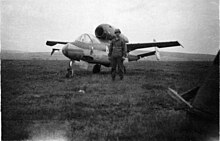Hunter emergency program




The term Jäger Emergency Program refers to a concept developed by the Reich Aviation Ministry towards the end of the Second World War , which was intended to put a stop to the Allied bomber offensive by building mass-produced interceptors .
concept
The background to the program was the intensified Allied bombing raids against German industrial targets and cities from the beginning of 1944 . For this reason, the Luftwaffe decided in November 1944 to completely stop the production of bombers in favor of fighter planes . These aircraft were to repel bomb attacks and relieve the war industry. In this respect, the announcement of the hunter emergency program represents a departure from the previously propagated “retaliation” of the Allied attacks.
In addition to increasing production, new types should also be used. The aircraft developed should meet various criteria:
- modern propulsion technology through rocket or jet propulsion to escape the escorting aircraft and only to be able to attack bombers.
- Easy to control flight behavior, so that it can also be flown by quickly trained pilots from the Hitler Youth or the Volkssturm .
- Use of readily available materials such as wood or iron to enable quick and cheap mass production.
- Short take-off capabilities and high rate of climb (as an object protection fighter, long flight times were unnecessary).
As part of the program, completely new aircraft designs were therefore considered, such as rocket planes such as the Messerschmitt Me 163 or the Bachem Ba 349 , which in the latter case even took off vertically and could only fly a single mission - a landing was not planned, the pilot had to get out. Non-powered “combat gliders” and even “self-sacrificed planes” were considered.
Actual course
Most of the numerous designs did not get beyond project or model status due to the end of the war that soon followed. Only the Heinkel He 162 "Volksjäger" and Bachem Ba 349 "Natter", developed from the summer of 1944, were tested . Combat missions of these types only took place on the He 162 to a small extent. The flight tests and operations of this type are remarkable, because the desired ease of use was not given in the opinion of test pilots and flight experts. Conceptual errors such as the short flight time also caused numerous fatal accidents. In this way the “Volksjäger” concept would have become obsolete.
Despite the factual failure of the fighter emergency program, the drafts already anticipated numerous later important technologies in aircraft construction. In addition to modern jet engines, these were also developments such as delta and swept wings , ejection seats , swivel wings and VTOL . On the other hand, however, numerous concepts devised within the framework of the program represented rather desperate measures. The rocket propulsion system for airplanes also failed to gain acceptance.
See also
- German aircraft in World War II
- Retaliatory weapon
- Wonder weapons in World War II
- Air War in World War II
Individual evidence
- ^ Ulrich Albrecht : Artifacts of Fanaticism - Technology and National Socialist Ideology in the Final Phase of the Third Reich . In: Science and Peace eV (Ed.): W&F Science and Peace . No. 4 . BdWi-Verlag, Marburg 1989 ( article on W&F [accessed December 15, 2019]).
